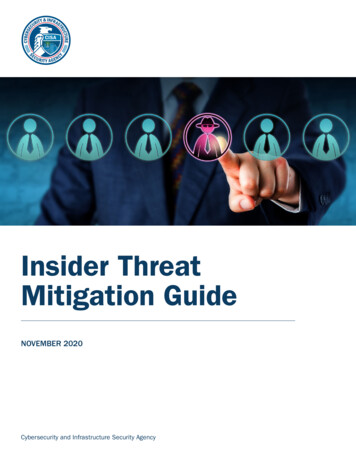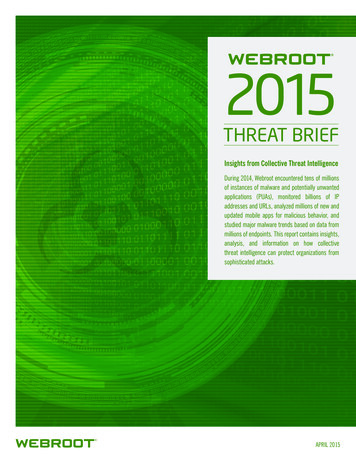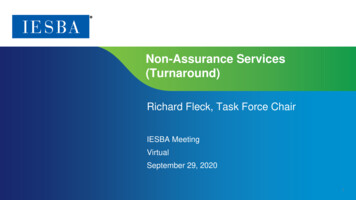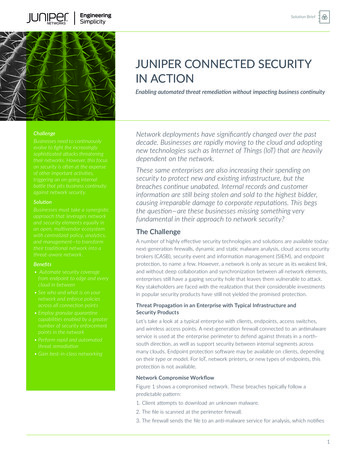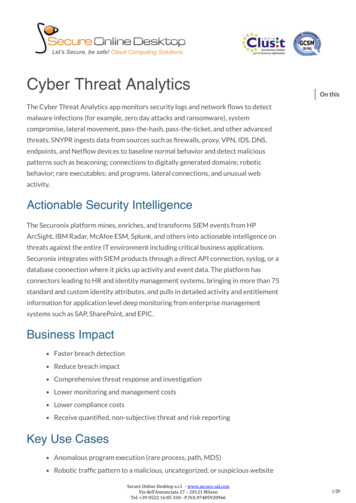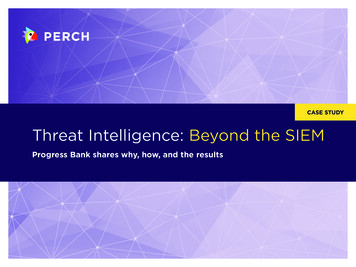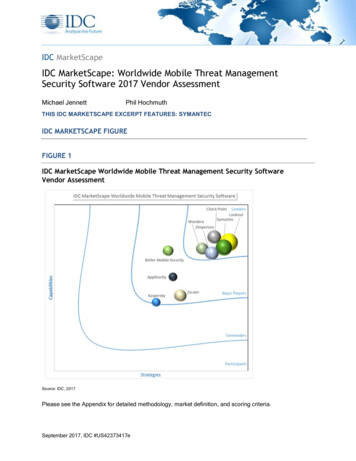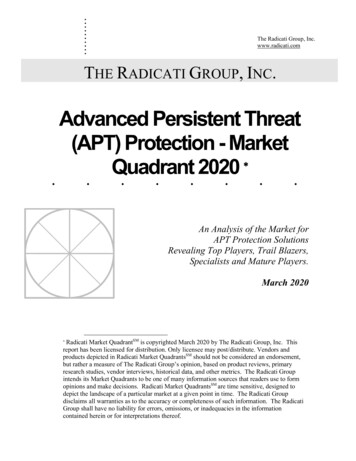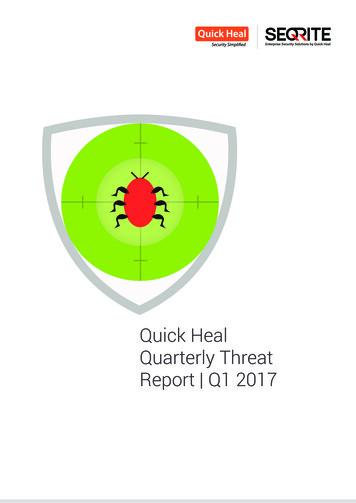
Transcription
Enterprise Security Solutions by Quick HealQuick HealQuarterly ThreatReport Q1 2017
About Quick HealIntroductionQuick Heal Technologies Ltd.(Formerly Known as Quick HealTechnologies Pvt. Ltd.) is one ofthe leading IT security solutionscompany. Each Quick Healproduct is designed to simplify ITsecurity management for homeusers, small businesses,Government establishments, andcorporate houses.In Q1 2017, about 295 million malware samples were detected onthe systems of Quick Heal users - February clocked the highestnumber of detection. Compared with Q1 2016, however, this quartersaw a drop of 13.61% in the detection count. Trojan horse malwarefamily continues the tradition of having the highest detection of all,followed by infectors, worms, and adware. Quick Heal Labsdetected 10 new ransomware families in this quarter. A notableobservation was made against a ransomware that uses NSISinstallers (Nullsoft Scriptable Install System, a professional opensource system to create Windows installers) to evade antivirussoftware. In targeted attacks observed in Q1 2017, malware thatmade news included ‘EyePyramid’, a Dridex banking malwarevariant, and the Windows version of the infamous botnet Mirai.Speaking of the Android platform, Quick Heal Labs received over 2million samples - an increase of 31% in comparison with Q1 2016.Third-party app stores were found to be the most common sourceof malware in the top 10 Android malware list. Compared with Q12016, Q1 2017 registered a massive growth of 200% of Androidransomware. The growth of Android Banking Trojans has been 10%less than the growth observed in Q1 last year. Important trends andpredictions to watch out for include evolution of ransomware,targeted attacks on IoT devices, Cloud services, and rising securityvulnerabilities on Android devices.www.quickheal.comFollow us on:
ContentsContributors:Anita LadkatDipali ZureLishoy MathewPranali MorePrashil MoonPriyanka DhasadeSagar KadamShraddha KhedkarTejas GirmeLeena ChaudhariPrachi SudameSanket TemgireSandip BorseSwati PharateWindows Malware Detection Statistics01Top 10 Windows Malware01Malware Category-wise Detection Statistics06Top 10 Potentially Unwanted Applications and Adware06Top 10 Windows Exploits07Major Windows Malware08Trends and Predictions11Android Samples and their Detection Statistics12Top 10 Android Malware13Android Ransomware and Android Banking Trojans17Android Malware Using Unique Techniques18Vulnerabilities and Android OS19Trends and Predictions20Conclusion21
Windows Malware Detection StatisticsIn Q1 2017, we detected over 295 million malware samples on ourusers’ machines.989000009884700898800000Compared with Q1 2016, Q12017 registered a drop of13.61% in the detection countof Windows malware ebMarFig 1Top 10 Windows MalwareThese are the top 10 Windows malware detected by Quick Heal in Q1 2017.3.75%2.80% 19.71%Fig 2Share this ReportQuick Heal Threat Report Q1 2017 01
Top 10 Windows Malware1. W32.Sality.UThreat Level: MediumCategory: Polymorphic file infectorMethod of Propagation: Removable or network drivesBehavior: Injects its code into all running system processes. It then spreadsfurther by infecting the executable files on local, removable, andremote shared drives. Tries to terminate security applications and deletes all files related toany security software installed on the system. Steals confidential information from the infected system.2. Trojan.Starter.YY4Threat Level: HighCategory: TrojanMethod of Propagation: Email attachments and malicious websitesBehavior: Creates a process to run the dropped executable file. Modifies computer registry settings which may cause a systemcrash. Downloads other malware like keyloggers. Slows down the booting and shutting down process of the infectedcomputer. Allows hackers to steal confidential data like credit card details andpersonal information from the infected system.3. Trojan.NSIS.Miner.SDThreat Level: HighCategory: TrojanMethod of Propagation: Bundled software and freewareBehavior: Enters a targeted system through hacked websites or unverifiedlinks. Downloads or installs free software from malicious websites. Automatically executes when the system starts. Modifies important system files and Windows registry settings. Makes excessive use of system resources for bitcoin mining whichfurther degrades the infected system’s performance. Opens a backdoor for other malware to enter the infected system.Share this ReportQuick Heal Threat Report Q1 2017 02
Top 10 Windows Malware4. TrojanDropper.Dexel.A5Threat Level: HighCategory: TrojanMethod of Propagation: Email attachments and malicious websitesBehavior: Allows entry of other malware into the infected system. Changes registry and browser settings. Automatically redirects the user to malicious websites to drop moreTrojan malware on the system. Steals confidential data from the infected system and can alsodestroy the data. Slows down system performance by consuming more resources.We're in the stone age ofcyber security. Real learningwill only come after the 1stmajor incident.– Dr Christopher Frei, SecretaryGeneral of World Energy Council5. Worm.Mofin.A3Threat Level: MediumCategory: WormMethod of Propagation: Removable or network drivesBehavior: Uses the Windows Autorun function to spread via removable drives. Creates an autorun.inf file in infected drives which containinstructions to launch the malware automatically when theremovable drive is connected to a system. Searches for documents with extensions such as .doc, .docx, .pdf,.xls, and .xlsx. Copies the files it finds and sends them via an SMTP to the attacker.6. PUA.Mindsparki.GenThreat Level: MediumCategory: Potentially Unwanted ApplicationMethod of Propagation: Bundled software and malicious websitesBehavior: Changes the infected system’s Internet browser homepage anddefault search engine to ask.com or yahoo.com. Installs a toolbar powered by ask.com. Asks the user to download software mentioned on the toolbar.Share this ReportQuick Heal Threat Report Q1 2017 03
Top 10 Windows Malware7. Trojan.EyeStye.AThreat Level: HighCategory: TrojanMethod of Propagation: Removable and remote shared drivesBehavior: Copies itself on the targeted drive and modifies registry entries toexecute itself automatically. Copies and uses autorun.inf files to execute automatically on thetargeted system. Rapidly spreads from one system to another. Steals important data from the victim’s computer and sends itremotely to the attacker. Degrades system performance by consuming more resources.Only after users have beenfake-phished will they reallypay attention to the training.– Todd Fitzgerald, Grant ThorntonInternational global director ofInformation Security8. Trojan.Suloc.A4Threat Level: HighCategory: TrojanMethod of Propagation: Bundled software and freewareBehavior: Modifies system settings. Consumes more system resources leading to poor systemperformance. Invites other malware into the infected system like spyware,keyloggers, and other harmful infections. While browsing, it redirects the user to malicious websites whichtrigger the download of malicious content. Spreads through the network and infects other connectedcomputers. Can cause a computer to crash or shut down abruptly.9. Worm.Necast.A3Threat Level: MediumCategory: WormMethod of Propagation: Spam emails and malicious websitesBehavior: Infects a computer via spam emails or when a user visits a websitethat is loaded with exploits.Share this ReportQuick Heal Threat Report Q1 2017 04
Top 10 Windows Malware W32.Sality.U was the top 2Windows malwaredetected in Q1 2016 (23%)and it has moved to the topposition in Q1 2017 (25.09%).Comes attached with freeware. It does not need to attach itself to thehost program in order to perform its operation. It simply takesadvantage of network connections in order to reproduce copies ofitself and propagate parts of itself onto other systems.Exploits the infected system’s vulnerabilities so that it can drop andinstall additional threats such as Trojans, keyloggers, fake antivirusprograms, and even ransomware.Helps remote attackers misuse the infected system’s vulnerabilitiesto access the compromised machine without the user’s knowledgeand consent.10. PUA.Askcom.GenThreat Level: LowCategory: Potentially Unwanted ApplicationMethod of Propagation: Bundled software and freewareBehavior: Adds extensions to Internet browsers which modify browser settingsredirecting the user to malicious websites. Tracks the user’s activities on the Internet without their knowledge. Sends the collected data to a remote server for delivering targetedadvertising. Triggers unwanted pop-up ads.Share this ReportQuick Heal Threat Report Q1 2017 05
Malware Category-wise Detection StatisticsThe below graph represents the statistics of the categories of Windowsmalware that were detected by Quick Heal in Q1 2017.45.00%Detections in descendingorder (average):Trojan: 37% Adware & PUA:24% Infector: 21%Worm: %11.78% arInfectorsWormExploitFig 3Top 10 Potentially Unwanted Applicationsand AdwarePotentially Unwanted Applications (PUAs) are not necessarily harmfulbut might lead to security concerns when used. Adware are softwareused to display ads to users - some are legitimate while some are usedto drop spyware that steals user information.PUA.Mindsparki.Gen toppedthe PUAs and Adware list in Q12016 (36%) and it has retainedits place in Q1 2017 with aslightly reduced detection rateof 25.58%.These are the top 10 PUAs and Adware samples detected by Quick Healin Q1 2017.2.88%2.63% .NetFilter.PB9Fig 4Share this ReportQuick Heal Threat Report Q1 2017 06
Top 10 Potentially Unwanted Applicationsand AdwareNewly observed Adware and PUAs in Q1 2017Adware.DealPlyComes with third-party bundled installer applications and softwaredownloaders. It injects advertising banners on web pages visited byusers.PUA.Chenchengc.GenEnters into a user’s computer without their knowledge. It gets installedwith the name ‘WinZipper’ or ‘QKSee’ or both.PUA.Yangliu.GenComes with third-party bundled software. It shows ads and pop-ups onweb browsers, may change browser homepage and redirect the user toadvertisement websites.PUA.Llcmailru.GenChanges browser settings like homepage and search engine; also addsunwanted toolbars.Top 10 Windows ExploitsA computer exploit is defined as an attack designed by a hacker to takeadvantage of a particular security vulnerability the targeted system has.These are the top 10 Windows exploits of Q1 s at the top of the list in Q12016 (31%) and it hasretained its position in Q12017 with a reduceddetection rate of 5-2545Fig 5Share this ReportQuick Heal Threat Report Q1 2017 07
Major Windows MalwareRansomwareRansomware is a malware that locks an infected system’s desktopscreen or encrypts the data stored on it. It then demands a ransom forletting go of the system or the data. One of the widespread ransomware observed in Q1 2017 is theDharma Ransomware, a decedent of the Crysis Ransomware. Filesencrypted by this malware have the ‘.dharma’ extension. Asobserved by Quick Heal Threat Research Labs, the master key ofthis ransomware has been leaked. We have used the key to developa Decryption Tool to help affected users. The tool can now bedownloaded for free by clicking on the link given ecryption-tool/ Globe Ransomware is another malware that was found to behacking into the victim’s system with Remote Desktop services. Asof now, three versions of this ransomware have been observed.Each one uses its own set of extensions to append the files theyencrypt. Quick Heal Labs was able to develop a tool which candecrypt files having some of these extensions. The tool can bedownloaded from the link given below:http://bit.ly/2mQFrKp New ransomware strains observed in Q1 2017 Sage 2.0SatanMerryChristmasOpentoyouFireCrypt CryptoShield 1.0CancerJobCryptZykaSpora Ransomware encrypted in NSIS installersIt has been observed in the last few months that ransomwarecreators are extensively using NSIS installers (Nullsoft ScriptableInstall System - a professional open source system to createWindows installers) with embedded components for encryption toevade antivirus detections. The embedded component in the NSISinstaller is a custom DLL which is accompanied by an encryptedcomponent having file sizes varying from 20 KB to 800 KB. The DLLcomponent is used to decrypt the encrypted component which isthe actual ransomware payload. This payload remains in theprocess memory and is never dropped onto the disk. From theanalyzed ransomware samples and embedded NSIS components,the following two encryption mechanisms have been observedwhich are evolving with time.Share this ReportQuick Heal Threat Report Q1 2017 08
Major Windows Malware1. Usage of custom decryption algorithmThe encrypted component itself follows a specific file structurewhich contains initial garbage bytes. It is followed by a hard-codedkey which is of a fixed size. Furthermore, it has a list of WindowsFunctions a.k.a. APIs which are used for process code injection. Theactual ransomware payload is stored in an encrypted form in thefile. The decryption is performed by using specific keys and customdecryption algorithm and APIs.2. Usage of Windows Crypto APIsThe encrypted component from NSIS contains an encryptedransomware payload which can be decrypted using WindowsCrypto APIs. The symmetric algorithm like AES-256, RC2 and 3DESare used for decrypting where the key for decryption is the NSISextracted component file name. The content obtained afterdecryption is an RtlCompressed executable file.This technique was found to be effective in evading detection bysecurity products. Ransomware families like Cerber and Locky werealso using this encrypting mechanism in its initial phase to evade thedetection. It has gotten more evolved with customization and is beingused extensively in developing other ransomware families such asGenasom, Firecrypt, Teerac, and Troldesh.Targeted AttacksThese attacks target a specific entity's financial and private data. Theseare carried out as a long-term attack running silently in breachedsystems and staying undetected by installed security software.1. The EyePyramid malware was used by attackers to target manyhigh profile Italian personnel with an attempt to steal data. Spearphishing emails were used as an infection vector to deliver malwareto the victims. When installed, it can give an attacker the access tothe infected system resources.2. A variant of the infamous Dridex banking malware was observed inthe beginning of Q1 2017 having UAC (User Access Control) bypasscapability. With this, the malware was able to execute withoutalerting the user to unknown files. It drastically increased thechances of the victim getting infected with this malware andperforming its stealing operations by making modifications in theinfected system.Share this ReportQuick Heal Threat Report Q1 2017 09
Major Windows Malware3. In 2016, we had found the Linux version of the Mirai botnet carryingout DDoS attacks on IoT devices. In Q1 2017, we came across itsWindows version. This new version scans the IP addresses of thetargeted devices and tries to log in to them. If logged successfully, itfinds the installed Operating System and drops bots accordingly.These bots further look for other targets.Potentially Unwanted Applications and AdwarePUAs and Adware display pop-up ads on users’ computer. There aremany publishers who provide custom toolbars, free applications,software bundlers or downloaders from websites other than theproduct publisher’s website.As the world is increasinglyinterconnected, everyoneshares the responsibility ofsecuring cyberspace.– Newton Lee, Counterterrorismand CybersecurityAttackers make use of these services to reach the user’s system bybundling unwanted or harmful software without the user’s knowledge.This triggers ad banners on the user’s computer screen or redirection towebsites hosting ads. Adware can steal information about the user’scomputer configuration so that they can display ads based on the user‘scomputer configuration.If the user falls for the bait and clicks on the displayed ads, an adwarecan track the ads clicked by the user or opened for a long time,displaying more ads based on this information. Some types of adwareare also designed to trigger audio ads in the background.In Q1 2017, we observed Adware that installs fake or unwanted PCoptimization program. Upon installation, these programs start scanningthe user’s computer, show fake alerts and detections, and ask the userto fix the issues. When the user clicks on the ‘fix issues’ notification, theyare prompted to ‘buy a product’. Although this product looks like agenuine scanner, it is a fake.Share this ReportQuick Heal Threat Report Q1 2017 10
Trends and PredictionsRansomwareNewer ransomware familiesare more advanced andpersistent. Looking at theprogress of last couple ofyears in ransomwarecategory it looks like thisthreat is going to stay forlong and become more andmore sophisticated andcomplex in years to come.– Sanjay Katkar,MD & CTO, Quick Heal Technologies Ltd. In Q2 2017, ransomware variants may continue to evolve. Locky Ransomware is expected to hit its targets with new andadvanced variants. We can expect to see a drastic increase in the number of Lockysamples being distributed via spam emails or exploits. Ransomware-as-a-Service (RaaS) type attacks may increase due toits user friendliness. Old ransomwares like CryptXXX, Teslacrypt, etc., have already showntheir impact by replicating themselves with improved propagatingcapability, encryption, and anti-detection techniques; this trend islikely to continue in Q2 2017. Given their profitability, ransomware attacks are predicted to increasein the coming quarter.Targeted Attacks IoT (Internet of Things) devices are expected to be hit with new botnetfamilies. After Linux, the Windows variant of the Mirai botnet hasalready been discovered with new capabilities. We can expect Mirai toevolve further and target IoT devices. Attackers can target PoS (Point of Sale) terminals and online paymentsystems due to the increased use of many cashless paymentoptions.Adware Increase in theft of bank related information leading to loss of money. More adware may begin using audio ads.Share this ReportQuick Heal Threat Report Q1 2017 11
Android Samples and their Detection StatisticsIn Q1 2017, we received over 2 million Android samples.Android samples received at Quick Heal18387952412155(Q1 2016 vs Q1 2017)Q1 2016Q1 2017Fig 1Android samples received at Quick Heal(Q1 2016 vs Q1 2017) Monthly ared with Q1 2016, Q12017 registered a rise of 31.1%in the total number of Androidsamples received at QuickHeal Labs (fig 2).Q1 2017953445Q1 2016FEBUARYMARCHFig 2Category detection(Q1 2016 vs Q1 2017)42%41%37%13%21%Malware growth has increasedfrom 21% (Q1 2016) to 46%(Q1 2017) and so has thegrowth of PotentiallyUnwanted Applications(PUAs).Q1 201746%Q1 2016MALWAREPUAADWAREFig 3Share this ReportQuick Heal Threat Report Q1 2017 12
Top 10 Android MalwareThese are the top 10 Android malware detected by Quick Heal inQ1 319%Android.Gmobi.A12%Fig 41. Android.Jiagu.AThreat Level: MediumCategory: Potentially Unwanted Application (PUA)Method of Propagation: Third-party app stores and protector plug-insBehavior: Uses the ‘Jiagu’ Android app protector. This protector is commonlyused by developers to prevent their apps from being tampered ordecompiled. This technique makes it difficult to run reverse engineering on themalicious app because it encrypts the dex file and saves it in nativefiles. It releases the data into memory and decrypts it while runtime. Decrypted DEX file may be a malicious or a clean file.2. Android.Airpush.JThreat Level: LowCategory: AdwareMethod of Propagation: Third-party app stores and repacked appsShare this ReportQuick Heal Threat Report Q1 2017 13
Top 10 Android MalwareBehavior: Displays multiple ads while it is running. When the user clicks on one of these ads, they get redirected to athird-party server where they are prompted to download and installother apps. Shares information about the user’s device location with athird-party server.3. Android.Smsreg.DARansomware is more aboutmanipulating vulnerabilitiesin human psychology thanthe adversary’s technologicalsophistication.– James Scott, Sr. Fellow, Institute forThreat Level: MediumCategory: Potentially Unwanted Application (PUA)Method of Propagation: Third-party app storesBehavior: Asks targeted Android users to make payments throughPremium Rate SMSs in order to complete their registration. Collects personal information such as phone numbers, incomingSMS details, device ID, contacts list, etc., and sends it to a remoteserver.Critical Infrastructure Technology4. Android.Downloader.KThreat Level: HighCategory: TrojanMethod of Propagation: Third-party app storesBehavior: Looks like a genuine app and when opened, it redirects the user to aGoogle’s settings web page. In the background, the app connects to a third-party server. The server responds to the app with a waiting time before it canperform further activities on the infected device. Once the waiting time lapses, it downloads other malicious apps onthe device.5. Android.Youmi.GEN13409Threat Level: LowCategory: Potentially Unwanted Application (PUA)Method of Propagation: Third-party app storesShare this ReportQuick Heal Threat Report Q1 2017 14
Top 10 Android MalwareBehavior: Displays 10 apps and asks the user to download them to get certainrewards. There is a condition not to uninstall the app for a minimum of 10days. Even if the user abides by this condition, they receive norewards. The app further recommends the user to share and earn morerewards. Causes unnecessary usage of mobile data.As observed in the ‘Behavior’section, most these malwareare designed to collect andshare device information witha third-party source.6. Android.Leech.GEN10401Threat Level: MediumCategory: Trojan-dropperMethod of Propagation: Third-party app storesBehavior: When opened for the first time, the app hides. If the app is opened again, it drops other malicious apps on thedevice. Dropped files further connect to harmful URLs. Shares information of the infected device with a remote server.7. Android.Qysly.GEN11686Threat Level: HighCategory: Trojan-dropperMethod of Propagation: Third-party app storesBehavior: When opened for the first time, the app hides and runs in thebackground without the user knowing about it. Displays continuous ads and prompts the user to download otherapps. Carries a file within itself which it decrypts and then executes it. Thisfile is usually an adware. Creates an ad’s URL shortcut on the home screen and opens the linkin the browser. Shares information about the infected device with a remote server.8. Android.gQMF.GEN9857Threat Level: MediumCategory: Potential Unwanted Application (PUA)Method of Propagation: Third-party app storesShare this ReportQuick Heal Threat Report Q1 2017 15
Top 10 Android MalwareAs always, most maliciousapps are spreadthrough third-party app stores.Behavior: Starts displaying ads after it is opened by the user. If the user clicks on one of these ads, other apps are downloaded andinstalled on the device. These installed apps could be clean orsuspicious. Creates a shortcut on the home screen, clicking on whichautomatically downloads that particular app. Collects and shares information about the device and installed appswith a remote server.9. Android.Autosus.GEN10363Threat Level: HighCategory: TrojanMethod of Propagation: Third-party app storesBehavior: When opened, it prompts the user to grant ‘Device Admin’ privileges.Even if the user clicks on ‘cancel’ it keeps asking them to enable theDevice Admin privileges. If the Device Admin privileges are granted, the app hides its icon butkeeps running in the background. Collects all incoming SMSs and sends them to a remote server. Itcan also update and delete all SMSs stored on the device. If the user removes its Device Admin privileges, the app again startsprompting the user to enable the same. Shares information such as IMEI, model number, manufacturedetails, email ID, and Android Version with a remote server.PUAs and Trojans comprise80% of this list.10. Android.Gmobi.AThreat Level: HighCategory: AdwareMethod of Propagation: Third-party app stores and repacked appsBehavior: Makes use of SDK to easily recompile other genuine apps. Downloads other apps on the device causing unnecessary memoryusage. Shares device information such as location and email account witha remote server. Displays unnecessary advertisements.Share this ReportQuick Heal Threat Report Q1 2017 16
Android Ransomware and Android BankingTrojansAndroid ransomware works in the same fashion like Windowsransomware do. The malware can lock your device or encrypt the storeddata and demand a ransom to put things back to normal.Banking Trojans (also known as Banker Trojan-horse) are programsused to obtain sensitive information about customers who use onlinebanking and payment systems.Below is the statistics of Android ransomware and Android BankingTrojans detected by Quick Heal in Q1 2017.Android ransomware(Q1 2016 vs Q1 2017)30252015Compared with Q1 2016, Q12017 registered a massivegrowth of 200% in the growthof Android ransomware (fig 5).1210504Q1 2016Q1 2017Fig 5Android banking Trojans(Q1 2016 vs Q1 2017)1210The growth of AndroidBanking Trojans, however,seemed to have melloweddown by 10% (fig 6).10986420Q1 2017Q1 2016Fig 6Share this ReportQuick Heal Threat Report Q1 2017 17
Android Malware Using Unique TechniquesI. DroidPlugin - being used by malware authors DroidPlugin is a framework originally developed for the purpose ofhot patching. The popular use of DroidPlugin is to launch multiple instances ofapps on the same device. It can directly load and launch an app from its APK file withoutinstallation. All plugin apps share the same UID with the host app. The host app has pre-defined components and permissions forplugin apps. Examples of malware using DroidPLugin Android.Dnotua.A (Adware) Android.Iop.ZII. Android.Boogr.A Has a similar icon like that of Google Play. Asks for administrative privileges and deletes its icon from thehome screen. Receives commands from a C&C server. Checks the infected device for any banking or payment apps. Receives a list of attacked banking apps from its C&C server. Collects the list of phone numbers from the contact list and sendsSMSs. To hide any banking transaction related messages, it forwardsreceived messages and then deletes the original. Whenever the user opens apps like Whatsapp, Facebook, Viber,etc., the malware displays a ‘purchase window’ which seems likeit is from Google Play. If the user provides any personal or bankinginformation, it goes to the attacker. Also checks if any antivirus app is installed on the device. Collects information about the device’s location.III. Android.Spynote.A Uses a fake icon of Netflix App (subscription service for watchingTV episodes and movies on phone). If clicked on, it hides and runs in the background.Share this ReportQuick Heal Threat Report Q1 2017 18
Android Malware Using Unique Techniques Activates the device’s microphone and listens to liveconversations without user knowledge. Records screen captures and reads SMSs and contact list. Shares all collected data with its C&C server. Can be used remotely by the attacker to root the user's deviceusing vulnerabilities.Compared with Q1 2016, Q12017 registered a giantincrease of 1200% (approx.) inthe security vulnerabilities usedfor ‘Code Execution’ (fig 7).Vulnerabilities and Android OSA security vulnerability (also known as a security hole) is a security flawdetected in a product that may leave it open to hackers and malware.Fig 7 represents the growth of security vulnerabilities in Q1 2016 vs Q12017.Security vulnerabilities discovered(Q1 2016 vs Q1 2017)10092908070The detections of almost allvulnerabilities are higher in thisquarter when compared withQ1 2016.604950403020158100262615Denial Of ServiceCode ExecutionOverflow101310Memory CorruptionQ1 2016Q1 201715Bypass something1611Gain Information21Gain PrivilegesSource: cvedetails.comFig 7Share this ReportQuick Heal Threat Report Q1 2017 19
Trends and PredictionsCloud security is a growing concernMany organizations are making a rapid shift to Cloud due to itspopularity and its scores of benefits. This means more sensitive data isbeing stored on Cloud every day. This trend is bound to attract theattention of attackers m
PUA.Chenchengc.Gen Enters into a user's computer without their knowledge. It gets installed with the name 'WinZipper' or 'QKSee' or both. PUA.Yangliu.Gen Comes with third-party bundled software. It shows ads and pop-ups on web browsers, may change browser homepage and redirect the user to advertisement websites. PUA.Llcmailru.Gen

